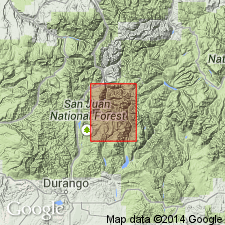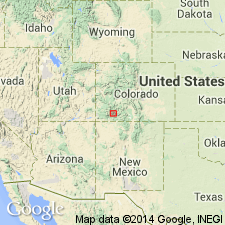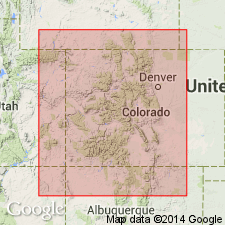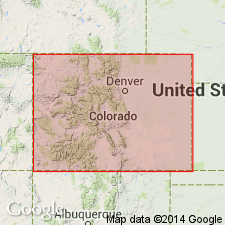
- Usage in publication:
-
- Twilight granite*
- Modifications:
-
- Original reference
- Dominant lithology:
-
- Granite
- AAPG geologic province:
-
- Southern Rocky Mountain region
Summary:
Twilight granite. Light grayish-pink gneissoid granite. Intrudes the Archean schists in this quadrangle and in Engineer Mountain quadrangle. Composes Twilight Peak, [west of Animas River, Needle Mountains 15-min quadrangle, San Juan County, southwestern Colorado]. Does not intrude the Algonkian rocks. [Age is pre-Cambrian.]
[GNC remark (ca. 1936, US geologic names lexicon, USGS Bull. 896, p. 2203): Was assigned to "Algonkian" by E.S. Larsen in USGS Bull. 843, 1933. The terms "Algonkian system" and "Archean system" were discarded by the USGS in 1934. For 1935 Colorado geol. map this formation was included in Front Range granite group and assigned to pre-Cambrian.]
Source: US geologic names lexicon (USGS Bull. 896, p. 2203).

- Usage in publication:
-
- Twilight Gneiss*
- Modifications:
-
- Redescribed
- Geochronologic dating
- Overview
- Dominant lithology:
-
- Gneiss
- AAPG geologic province:
-
- Southern Rocky Mountain region
Summary:
Renamed from Twilight Granite to Twilight Gneiss. Consists of gray, partly pink, green, red gneiss of trondhjemitic to quartz monzonitic composition. Is fine to medium grained, homogeneous, except for ubiquitous and locally abundant slabby interlayers of amphibolite and for subordinate interlayers of other rocks. Ranges in composition from quartz diorite to quartz monzonite. Much of the light-colored oligoclase-bearing rock is trondhjemite. Mapped at west side of geologic sketch map in the Needle Mountains in La Plata and San Juan Cos, CO in the Southern Rocky Mountain region, as a unit younger than the Irving Formation and older than both the Tenmile and Bakers Bridge Granites. Covers an area of about 60 sq mi, underlying the central and western West Needle Mountains, Lime and Cascade Creek Canyons, Potato Hill, area east and southeast of Columbine Lake, and parts of Animas canyon. Has radiometric ages of 1,780 m.y. (U-Pb) and 1,805 m.y. (Rb-Sr). May have formed as complex sills of porphyritic dacite to quartz latite intruded in a flat or gently dipping pile of basalt layers, metamorphosed and folded, or as an interlayered basalt and silicic extrusive sequence, perhaps under marine conditions, and later folded and metamorphosed.
Source: GNU records (USGS DDS-6; Denver GNULEX).

- Usage in publication:
-
- Twilight Gneiss*
- Modifications:
-
- Overview
- AAPG geologic province:
-
- Southern Rocky Mountain region
Summary:
Included with rocks of pre-1,700 m.y., or Precambrian X, metamorphic complex. Used in Needle Mountains area.
Source: GNU records (USGS DDS-6; Denver GNULEX).

- Usage in publication:
-
- Twilight Gneiss*
- Modifications:
-
- Overview
- AAPG geologic province:
-
- Southern Rocky Mountain region
Summary:
The metavolcanic Early Proterozoic Twilight Gneiss of the Needle Mountains in the Southern Rocky Mountain region is the felsic counterpart of the amphibolitic Irving Formation. Is a homogeneous leucocratic foliated rock characterized by quartz ovoids (or eyes--probably recrystallized quartz phenocrysts). Ranges from quartz diorite to quartz monzonite, and much of it is trondhjemitic. Parent rocks were tuff flows and sills?.
Source: GNU records (USGS DDS-6; Denver GNULEX).
For more information, please contact Nancy Stamm, Geologic Names Committee Secretary.
Asterisk (*) indicates published by U.S. Geological Survey authors.
"No current usage" (†) implies that a name has been abandoned or has fallen into disuse. Former usage and, if known, replacement name given in parentheses ( ).
Slash (/) indicates name conflicts with nomenclatural guidelines (CSN, 1933; ACSN, 1961, 1970; NACSN, 1983, 2005, 2021). May be explained within brackets ([ ]).

